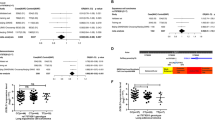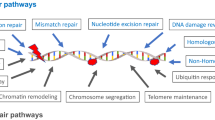Abstract
X-ray repair cross-complementing 1 (XRCC1) plays a key role in DNA base excision repair and cells lacking its activity are hypersensitive to DNA damage. Recently, we reported a SNP (rs3213245, −77T>C) in the XRCC1 gene 5′ untranslated region (UTR) was significantly associated with the risk of developing esophageal squamous-cell carcinoma. Computer analysis predicted that this SNP was in the core of Sp1-binding motif, which suggested its functional significance. Gel shift and super shift assays confirmed that −77T>C polymorphic site in the XRCC1 promoter was within the Sp1-binding motif and the T>C substitution greatly enhanced the binding affinity of Sp1 to this region. Luciferase assays indicated that the Sp1-high-affinity C-allelic XRCC1 promoter was associated with a reduced transcriptional activity. The association between −77T>C and three other amino-acid substitution-causing polymorphisms in XRCC1 and risk of lung cancer was examined in 1024 patients and 1118 controls and the results showed that only the −77T>C polymorphism was significantly associated with an increased risk of developing lung cancer. Multivariate logistic regression analysis found that an increased risk of lung cancer was associated with the variant XRCC1 −77 genotypes (TC and CC) compared with the TT genotype (OR=1.46, 95% CI=1.18–1.82; P=0.001) and the increased risk was more pronounced in smokers (OR=1.63, 95% CI=1.20–2.21) than in non-smokers (OR=1.28, 95% CI=0.94–1.76). Taken together, these results showed that the functional SNP −77T>C in XRCC1 5′UTR was associated with cancer development owing to the decreased transcriptional activity of C-allele-containing promoter with higher affinity to Sp1 binding.
This is a preview of subscription content, access via your institution
Access options
Subscribe to this journal
Receive 50 print issues and online access
$259.00 per year
only $5.18 per issue
Buy this article
- Purchase on Springer Link
- Instant access to full article PDF
Prices may be subject to local taxes which are calculated during checkout



Similar content being viewed by others
Abbreviations
- R:
-
base excision repair
- SCC:
-
squamous cell carcinoma
- PCR-RFLP:
-
polymerase chain reaction-based restriction fragment length polymorphism
- EMSA:
-
electrophoretic mobility shift assay
- OR:
-
odds ratio
- CI:
-
confidence interval
- SNP:
-
single nucleotide polymorphism
References
Caldecott KW . (2003). DNA Repair 2: 955–969.
Dean G, Young DA, Edwards DR, Clark IM . (2000). J Biol Chem 275: 32664–32671.
Ding K, Zhou K, He F, Shen Y . (2003). Bioinformatics 19: 2147–2148.
Duell EJ, Wiencke JK, Cheng TJ, Varkonyi A, Zuo ZF, Ashok TD et al. (2000). Carcinogenesis 21: 965–971.
Gonzalez FJ . (1995). Cancer Res 55: 710–715.
Goode EL, Ulrich CM, Potter JD . (2002). Cancer Epidemiol Biomarkers Prev 11: 1513–1530.
Hao B, Wang H, Zhou K, Li Y, Chen X, Zhou G et al. (2004). Cancer Res 64: 4378–4384.
Hecht SS . (2003). Nat Rev Cancer 3: 733–744.
Hoeijmakers JHJ . (2001). Nature 411: 366–374.
Hu JJ, Smith TR, Miller MS, Mohrenweiser HW, Golden A, Case LD . (2001). Carcinogenesis 22: 917–922.
Hu Z, Ma H, Lu D, Zhou J, Chen Y, Xu L et al. (2005). Pharmacogenet Genomics 15: 457–463.
Ioannidis JP, Trikalinos TA, Ntzani EE, Contopoulos-Ioannidis DG . (2003). Lancet 361: 567–571.
Kelsey KT, Park S, Nelson HH, Karagas MR . (2003). Cancer Epidemiol Biomarkers Prev 13: 1337–1341.
Lake SL, Lyon H, Tantisira K, Silverman EK, Weiss ST, Laird NM et al. (2003). Hum Hered 55: 56–65.
Li J, Ou JH . (2001). J Virol 75: 8400–8406.
Liang G, Xing D, Miao X, Tan W, Yu C, Lu W et al. (2003). Int J Cancer 105: 669–673.
Lunn RM, Langlois RG, Hsieh LL, Thompson CL, Bell DA . (1999). Cancer Res 59: 2557–2561.
Matullo G, Guarrera S, Carturan S, Peluso M, Malaveille C, Davico L et al. (2001a). Int J Cancer 92: 562–567.
Matullo G, Palli D, Peluso M, Guarera S, Garturan S, Celentano E et al. (2001b). Carcinogenesis 22: 1437–1445.
Mohrenweiser HW, Xi T, Vazquez-Matias J, Jones IM . (2002). Cancer Epidemiol Biomarkers Prev 11: 1054–1064.
Nakachi K, Imai K, Hayashi S, Kawajiri K . (1993). Cancer Res 53: 2994–2999.
Pagliuca A, Cannada-Bartoli P, Lania L . (1998). J Biol Chem 273: 7668–7674.
Palli D, Russo A, Masala G, Saieva C, Guarrera S, Carturan S et al. (2001). Int J Cancer 94: 121–127.
Schaid DJ, Rowland CM, Tines DE, Jacobson RM, Poland GA . (2002). Am J Hum Genet 70: 425–434.
Shen MR, Jones IM, Mohrenweiser H . (1998). Cancer Res 58: 604–608.
Shou Y, Baron S, Poncz M . (1998). J Biol Chem 273: 5716–5726.
Shu X, Cai Q, Gao YT, Wen W, Fan J, Zheng W . (2003). Cancer Epidemiol Biomarkers Prev 12: 1462–1467.
Sturgis EM, Castillo EJ, Li L, Zheng R, Eicher SA, Clayman GL et al. (1999). Carcinogenesis 20: 2125–2129.
Sun T, Miao X, Zhang X, Tan W, Xiong P, Lin D . (2004). J Natl Cancer Inst 96: 1030–1036.
Tebbs RS, Flannery ML, Meneses JJ, Hartmann A, Tucker JD, Thompson LH et al. (1999). Dev Biol 208: 513–529.
Thompson LH, Brookman KW, Jones NJ, Allen SA, Carrano AV . (1990). Mol Cell Biol 10: 6160–6171.
Vineis P . (1997). Int J Cancer 71: 1–3.
Wang H, Tan W, Hao B, Miao X, Zhou G, He F et al. (2003a). Cancer Res 63: 8057–8061.
Wang Y, Spitz MR, Zhu Y, Dong Q, Shete S, Wu X . (2003b). DNA Repair 2: 901–908.
Weinfeld M, Caldecott KW . (2001). Cell 104: 107–117.
Won J, Yim J, Kim TK . (2002). J Biol Chem 277: 38230–38238.
Wood RD, Mitchell M, Sgouros J, Lindahl T . (2001). Science 291: 1284–1289.
Xing D, Jun Q, Miao X, Lu W, Tan W, Lin D . (2002). Int J Cancer 100: 600–605.
Zhou W, Liu G, Miller DP, Thurston SW, Xu LL, Wain JC et al. (2003). Cancer Epidemiol Biomarkers Prev 12: 359–365.
Acknowledgements
This study was supported by National ‘863’ High Technology Project grants 2004AA221100 (F He) and 2002BA711A06 (D Lin), National Natural Science Foundation grant 30128020 (D Lin), and Chinese National Natural Science Foundation grants for Creative Research Groups 30321003 (F He).
Author information
Authors and Affiliations
Corresponding authors
Rights and permissions
About this article
Cite this article
Hao, B., Miao, X., Li, Y. et al. A novel T-77C polymorphism in DNA repair gene XRCC1 contributes to diminished promoter activity and increased risk of non-small cell lung cancer. Oncogene 25, 3613–3620 (2006). https://doi.org/10.1038/sj.onc.1209355
Received:
Revised:
Accepted:
Published:
Issue Date:
DOI: https://doi.org/10.1038/sj.onc.1209355
Keywords
This article is cited by
-
Genetic Polymorphisms Along with Dietary and Environmental Factors Enhance the Susceptibility to Nasopharyngeal Carcinoma in Nagaland of Northeast India
Biochemical Genetics (2020)
-
Single nucleotide polymorphisms in DNA repair genes and putative cancer risk
Archives of Toxicology (2016)
-
Association between polymorphisms in genes related to DNA base-excision repair with risk and prognosis of oropharyngeal squamous cell carcinoma
Journal of Cancer Research and Clinical Oncology (2016)
-
Note of clarification of data in the paper titled X-ray repair cross-complementing group 1 Arg194Trp polymorphism is associated with increased risk of lung cancer in Chinese Han population
Tumor Biology (2015)
-
Note of clarification of data in the paper entitled no association between XRCC1 gene Arg194Trp polymorphism and risk of lung cancer: evidence based on an updated cumulative meta-analysis
Tumor Biology (2015)



